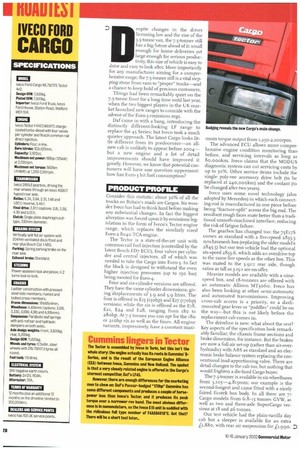km Ford Cargo ML 75E17S
Page 26

Page 28

If you've noticed an error in this article please click here to report it so we can fix it.
PRICE AS TESTED: £28,215 (ex-VAT). Includes 06,860 for standard chassis; £310 for six-speed gearbox; 1150 for central locking; £185 for cruise control; £150 for
radio-cassette; £260 for heated screen; £125 for electric windows; £200 for electric/heated mirrors; £125 for headlamp wash. Deduct £150 for deleted spare wheel option. ENGINE: 33 litres, 168hp (125kW). GVW: 7,500kg. BODY/PAYLOAD ALLOWANCE: 4,389kg. AVERAGE SPEED: 72.0km/h. AVERAGE FUEL CONSUMPTION: 19.2mpg (14.71it/100km).
Iveco's Euro-3 Cargo looks suspiciously similar to those we have seen before, but with a new engine and many chassis improvements. So can the most popular truck in Britain really stay ahead of the pack?
espite changes in the driver licensing law and the rise of the 3.5-tonne van, the 7.5-tonner still has a big future ahead of it: small enough for home deliveries yet large enough for serious productivity, this size of vehicle is easy to drive and easy to look after. More importantly for any manufacturer aiming for a comprehensive range, the 7.5-tonner still is a vital stepping stone from vans to "proper" trucks-and a chance to keep hold of precious customers, Things had been remarkably quiet on the 7.5-tonne front for a long time until last year, when the two biggest players in the UK market launched new ranges to coincide with the advent of the Euro-3 emissions regs.
Daf came in with a bang, introducing the distinctly different-looking LF range to replace the 45 Series; but lveco took a much quieter approach. The latest Cargo looks little different from its predecessor-an allnew cab is unlikely to appear before 2004but a new engine and a lot of detail improvements should have improved it greatly. However, we know that potential customers will have one question uppermost: how has Euro-3 hit fuel consumption?
PRODUCT PROFILE
Consider this statistic: about 30% of all the trucks on Britain's roads are Cargos. No wonder Iveco has had to think hard before making any substantial changes. In fact the biggest alteration was forced upon it by emissions legislation in the form of Iveco's Tector engine range, which replaces the similarly sized Euro-2 8040 TCA engine.
The Tector is a state-of-the-art unit with common-rail fuel injection (controlled by the latest Bosch ED7 ECU), four valves per cylinder and central injectors, all of which was needed to take the Cargo into Euro-3. In fact the block is designed to withstand the even higher injection pressures (up to 15o bar) being mooted for Euro-4.
Four and six-cylinder versions are offered. They have the same cylinder dimensions, giving displacements of 3.9 and 5.9 litres. The four is offered in E15 (i5ohp) and £17 (i7ohp) versions; while the six is offered as the E8, £21, £24 and E28, ranging from 18o to 28ohp. At 7.5 tonnes you can opt for the i8o or 2rohp six as well as the fours. All engine variants, impressively, have a constant maxi
mum torque output from 1,25 0-2,100IpM.
The advanced ECU allows more compre. hensive engine condition monitoring than before, and servicing intervals as long as 8o,000km. Iveco claims that the MODUS diagnostic system can cut servicing costs by up to 30%. Other service items include the single poly-vee accessory drive belt (to be replaced at 240,000krn) and the coolant (to be changed after two years).
Iveco uses some novel technology (also adopted by Mercedes) in which each connecting-rod is manufactured in one piece before being "fracture-split" across the big end. The resultant rough faces mate better than a traditional smooth-machined interface, reducing the risk of fatigue failure, The gearbox has changed too: the 75E17S comes as standard with a five-speed 2855.5 synchromesh box (replacing the older model's 2845.5) but our test vehicle had the optional six-speed 2855.6, which adds an overdrive top to the same five speeds as the other box. This was mated to the 3.91:1 rear axle, though ratios as tall as 3.15:1 are on offer.
Heavier models are available with a ninespeed box, and I8-tormers are offered with an automatic Allison MT3o6o. Iveco has also been looking at other semi-automatic and automated transmissions. Improving cross-cab access is a priority, so a dash. mounted gear lever or "paddles" could be on the way-but this is not likely before the replacement cab comes in.
The driveline is new: what about the rest? Key aspects of the specification look remarkably familiar; the chassis frame sections and brake dimension, for instance. But the brakes are now a full-air set-up (rather than air-overhydraulic) with ABS as standard and an electronic brake balance system replacing the conventional load-apportioning valve. There are detail changes to the cab too, but nothing that would frighten a die-hard Cargo buyer.
The 7.5-tonner is available in six wheelbases from 3,105-4,815mm; our example is the second-longest and came fitted with a nicely faired Ecotek box body. In all there are 71 Cargo models from &8-i tonnes GVW, as well as two and three-axle SuperCargo versions at 18 and 26 tonnes.
Our test vehicle had the plain-vanilla day cab but a sleeper is available for an extra /1,88o, with rear air suspension for £1,990.
















































































































































